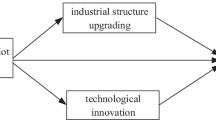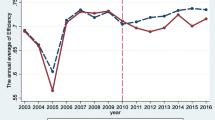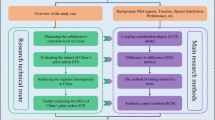Abstract
This study focuses on the impacts of low-carbon city pilot policy (LCCP) on pollution and carbon emissions and synergistic emission reduction efficiency, and then explores whether it can realize the synergistic effect of pollution and carbon reduction. Based on the panel data of 282 cities in China from 2006 to 2019, this paper treats LCCP as a quasi-natural experiment and tests its effect using difference-in-differences model. The results show that LCCP reduces pollution and carbon emissions and improves synergistic emission reduction efficiency, realizing synergistic effect of pollution and carbon reduction. The policy effects are mainly realized through strengthening technological innovation, tertiary industry employment and human capital. Heterogeneity analysis shows that the synergistic effect of pollution and carbon reduction of LCCP only exists in large cities and non-resource cities. Furthermore, LCCP promotes economic growth, so that it realizes the synergetic effect of pollution and carbon reduction without sacrificing GDP growth.



Similar content being viewed by others
Data availability
Data for this work are available through the corresponding author.
Notes
China Green National Accounts Research Report 2004.
The Heihe-Tengchong Line is a comparison of population density in China proposed by Chinese geographer Hu Huanyong in 1935. In this paper, the cities in Tibet, Xinjiang, Qinghai, Gansu, Inner Mongolia, and Ningxia are classified as the area west of the Heihe-Tengchong Line, whereas the cities in the remaining provinces (excluding Hong Kong, Macao, and Taiwan) are classified as the area east of the Heihe-Tengchong Line.
See the announcement on the implementation of special emission limits for air pollutants issued by the Chinese Ministry of Ecology and Environment https://www.mee.gov.cn/gkml/hbb/bgg/201303/t20130305_248787.htm.
The National Development and Reform Commission of China issued the Notice on the Pilot Project of Carbon Emission Trading in October 2011, and Shenzhen City took the lead in carbon trading in China in June 2013. Subsequently, Shanghai City, Beijing City, Tianjin City, Chongqing City, Hubei Province, and Guangzhou Province established carbon trading markets in 2014. Fujian Province was selected as a pilot region in 2017.
The 2019 population of municipal districts is used as the basis for classifying city size. Large cities have a population of more than 5 million, and small cities have a population of less than 5 million.
The planning scope includes 262 resource cities, of which 126 are prefecture-level administrative regions (including prefecture-level cities, regions, autonomous prefectures, leagues, etc.), and the list of specific resource cities is available at https://www.gov.cn/zwgk/2013-12/03/content_2540070.htm.
References
Barbera, A. J., & McConnell, V. D. (1990). The impact of environmental regulations on industry productivity: Direct and indirect effects. Journal of Environmental Economics and Management, 18(1), 50–65. https://doi.org/10.1016/0095-0696(90)90051-Y
Borghesi, S., Cainelli, G., & Mazzanti, M. (2015). Linking emission trading to environmental innovation: Evidence from the Italian manufacturing industry. Research Policy, 44(3), 669–683. https://doi.org/10.1016/j.respol.2014.10.014
Cai, X., Lu, Y., Wu, M., & Yu, L. (2016). Does environmental regulation drive away inbound foreign direct investment? Evidence from a quasi-natural experiment in China. Journal of Development Economics, 123, 73–85. https://doi.org/10.1016/j.jdeveco.2016.08.003
Cao, J., Ho, M. S., Ma, R., & Teng, F. (2021). When carbon emission trading meets a regulated industry: Evidence from the electricity sector of China. Journal of Public Economics, 200, 104470. https://doi.org/10.1016/j.jpubeco.2021.104470
Chen, C., Lin, Y., Lv, N., Zhang, W., & Sun, Y. (2022). Can government low-carbon regulation stimulate urban green innovation? Quasi-experimental evidence from China’s low-carbon city pilot policy. Applied Economics, 54(57), 6559–6579. https://doi.org/10.1080/00036846.2022.2072466
Chen, H., Guo, W., Feng, X., Wei, W., Liu, H., Feng, Y., & Gong, W. (2021). The impact of low-carbon city pilot policy on the total factor productivity of listed enterprises in China. Resources Conservation and Recycling, 169, 105457. https://doi.org/10.1016/j.resconrec.2021.105457
Chen, L., & Wang, K. (2022). The spatial spillover effect of low-carbon city pilot scheme on green efficiency in China’s cities: Evidence from a quasi-natural experiment. Energy Economics, 110, 106018. https://doi.org/10.1016/j.eneco.2022.106018
Chen, Y. J., Li, P., & Lu, Y. (2018). Career concerns and multitasking local bureaucrats: Evidence of a target-based performance evaluation system in China. Journal of Development Economics, 133, 84–101. https://doi.org/10.1016/j.jdeveco.2018.02.001
Cheng, J., Yi, J., Dai, S., & Xiong, Y. (2019). Can low-carbon city construction facilitate green growth? Evidence from China’s pilot low-carbon city initiative. Journal of Cleaner Production, 231, 1158–1170. https://doi.org/10.1016/j.jclepro.2019.05.327
Chetty, R., Looney, A., & Kroft, K. (2009). Salience and taxation: Theory and evidence. American Economic Review, 99(4), 1145–1177. https://doi.org/10.1257/aer.99.4.1145
Cui, J., Zhang, J., & Zheng, Y. (2018). Carbon pricing induces innovation: Evidence from China’s regional carbon market pilots. AEA Papers and Proceedings, 108, 453–457. https://doi.org/10.1257/pandp.20181027
Cui, L., Fan, Y., Zhu, L., & Bi, Q. (2014). How will the emissions trading scheme save cost for achieving China’s 2020 carbon intensity reduction target? Applied Energy, 136, 1043–1052. https://doi.org/10.1016/j.apenergy.2014.05.021
Currie, J., & Neidell, M. (2005). Air pollution and infant health : What can we learn from California’s recent experience? Quarterly Journal of Economics, 120(3), 1003–1030.
Dong, Z., Xia, C., Fang, K., & Zhang, W. (2022). Effect of the carbon emissions trading policy on the co-benefits of carbon emissions reduction and air pollution control. Energy Policy, 165, 112998. https://doi.org/10.1016/j.enpol.2022.112998
Edmonds, E. V., Pavcnik, N., & Topalova, P. (2010). Trade adjustment and human capital investments: Evidence from Indian tariff reform. American Economic Journal: Applied Economics, 2(4), 42–75.
Feng, Y., Ning, M., Lei, Y., Sun, Y., Liu, W., & Wang, J. (2019). Defending blue sky in China: Effectiveness of the “air pollution prevention and control action plan” on air quality improvements from 2013 to 2017. Journal of Environmental Management, 252, 109603. https://doi.org/10.1016/j.jenvman.2019.109603
Fisher-Vanden, K., Jefferson, G. H., Ma, J., & Xu, J. (2006). Technology development and energy productivity in China. Energy Economics, 28(5), 690–705. https://doi.org/10.1016/j.eneco.2006.05.006
Gao, D., Li, Y., & Li, G. (2022a). Boosting the green total factor energy efficiency in urban China: Does low-carbon city policy matter? Environmental Science and Pollution Research, 29, 56341–56356. https://doi.org/10.1007/s11356-022-19553-9
Gao, X., Liu, N., & Hua, Y. (2022b). Environmental protection tax law on the synergy of pollution reduction and carbon reduction in China: Evidence from a panel data of 107 cities. Sustainable Production and Consumption, 33, 425–437. https://doi.org/10.1016/j.spc.2022.07.006
Gehrsitz, M. (2017). The effect of low emission zones on air pollution and infant health. Journal of Environmental Economics and Management, 83, 121–144. https://doi.org/10.1016/j.jeem.2017.02.003
Gray, W. B. (1987). The cost of regulation: OSHA, EPA and the productivity slowdown. The American Economic Review, 77(5), 998–1006.
Greenstone, M., List, J., Syverson, C. (2012). The effects of environmental regulation on the competitiveness of US manufacturing. National Bureau of Economic Research (No. w18392).
Hamamoto, M. (2006). Environmental regulation and the productivity of Japanese manufacturing industries. Resource and Energy Economics, 28(4), 299–312. https://doi.org/10.1016/j.reseneeco.2005.11.001
He, Y., Lai, Z., & Liao, N. (2023). Evaluating the effect of low-carbon city pilot policy on urban PM2.5: Evidence from a quasi-natural experiment in China. Environment, Development and Sustainability. https://doi.org/10.1007/s10668-023-02906-w
Hering, L., & Poncet, S. (2014). Environmental policy and exports: Evidence from Chinese cities. Journal of Environmental Economics and Management, 68(2), 296–318. https://doi.org/10.1016/j.jeem.2014.06.005
Hoffmann, V. H. (2007). EU ETS and investment decisions: The case of the German electricity industry. European Management Journal, 25(6), 464–474. https://doi.org/10.1016/j.emj.2007.07.008
Huang, J., Yu, Y., & Ma, C. (2018). Energy efficiency convergence in China: Catch-up, lock-in and regulatory uniformity. Environmental and Resource Economics, 70(1), 107–130. https://doi.org/10.1007/s10640-017-0112-0
Huang, J., Zhao, J., & Cao, J. (2021). Environmental regulation and corporate R&D investment:Evidence from a quasi-natural experiment. International Review of Economics & Finance, 72, 154–174. https://doi.org/10.1016/j.iref.2020.11.018
Khanna, N., Fridley, D., & Hong, L. (2014). China’s pilot low-carbon city initiative: A comparative assessment of national goals and local plans. Sustainable Cities and Society, 12, 110–121. https://doi.org/10.1016/j.scs.2014.03.005
Khastar, M., Aslani, A., & Nejati, M. (2020). How does carbon tax affect social welfare and emission reduction in Finland? Energy Reports, 6, 736–744. https://doi.org/10.1016/j.egyr.2020.03.001
Kurtz, M. J., & Brooks, S. M. (2011). Conditioning the “Resource Curse”: Globalization, human capital, and growth in oil-rich nations. Comparative Political Studies, 44(6), 747–770. https://doi.org/10.1177/0010414011401215
Lan, J., & Munro, A. (2013). Environmental compliance and human capital: Evidence from Chinese industrial firms. Resource and Energy Economics, 35(4), 534–557. https://doi.org/10.1016/j.reseneeco.2013.05.003
Lee, C., & Lee, C. (2022). How does green finance affect green total factor productivity? Evidence from China. Energy Economics, 107, 105863. https://doi.org/10.1016/j.eneco.2022.105863
Li, D., Zhang, Y., & Ma, S. (2017). Would smog lead to outflow of labor force? Empirical evidence from China. Emerging Markets Finance and Trade, 53(5), 1122–1134. https://doi.org/10.1080/1540496X.2017.1282858
Li, P., Lu, Y., & Wang, J. (2016). Does flattening government improve economic performance? Evidence from China. Journal of Development Economics, 123, 18–37. https://doi.org/10.1016/j.jdeveco.2016.07.002
Li, Z., Bai, T., & Tang, C. (2022). How does the low-carbon city pilot policy affect the synergistic governance efficiency of carbon and smog? Quasi-experimental evidence from China. Journal of Cleaner Production, 373, 133809. https://doi.org/10.1016/j.jclepro.2022.133809
Liu, X., Li, Y., Chen, X., & Liu, J. (2022). Evaluation of low carbon city pilot policy effect on carbon abatement in China: An empirical evidence based on time-varying DID model. Cities, 123, 103582. https://doi.org/10.1016/j.cities.2022.103582
Lo, S., & Chang, M. (2014). Regional pilot carbon emissions trading and its prospects in China. Energy & Environment, 25(5), 899–913. https://doi.org/10.1260/0958-305X.25.5.899
Lu, H., Yue, A., Chen, H., & Long, R. (2018). Could smog pollution lead to the migration of local skilled workers? Evidence from the Jing-Jin-Ji region in China. Resources, Conservation and Recycling, 130, 177–187. https://doi.org/10.1016/j.resconrec.2017.11.024
Lu, M., Xu, H., & Chen, F. (2022). Pollution and carbon reduction effects of the carbon emissions trading mechanism in the context of the “dual carbon” goals. China Population, Resources and Environment, 32(11), 121–133.
Martínez-Zarzoso, I., Bengochea-Morancho, A., & Morales-Lage, R. (2019). Does environmental policy stringency foster innovation and productivity in OECD countries? Energy Policy, 134, 110982. https://doi.org/10.1016/j.enpol.2019.110982
Milani, S. (2017). The impact of environmental policy stringency on industrial R&D conditional on pollution intensity and relocation costs. Environmental and Resource Economics, 68(3), 595–620. https://doi.org/10.1007/s10640-016-0034-2
Pan, A., Zhang, W., Shi, X., & Dai, L. (2022). Climate policy and low-carbon innovation: Evidence from low-carbon city pilots in China. Energy Economics, 112, 106129. https://doi.org/10.1016/j.eneco.2022.106129
Pönkä, A. (1990). Absenteeism and respiratory disease among children and adults in Helsinki in relation to low-level air pollution and temperature. Environmental Research, 52(1), 34–46. https://doi.org/10.1016/S0013-9351(05)80149-5
Porter, M. E., & Linde, C. (1995). Toward a new conception of the environment-competitiveness relationship. Journal of Economic Perspectives, 9(4), 97–118. https://doi.org/10.1257/jep.9.4.97
Qiu, S., Wang, Z., & Liu, S. (2021). The policy outcomes of low-carbon city construction on urban green development: Evidence from a quasi-natural experiment conducted in China. Sustainable Cities and Society, 66, 102699. https://doi.org/10.1016/j.scs.2020.102699
Rubashkina, Y., Galeotti, M., & Verdolini, E. (2015). Environmental regulation and competitiveness: Empirical evidence on the Porter Hypothesis from European manufacturing sectors. Energy Policy, 83, 288–300. https://doi.org/10.1016/j.enpol.2015.02.014
Sachs, J. D., & Warner, A. M. (1999). The big push, natural resource booms and growth. Journal of Development Economics, 59(1), 43–76. https://doi.org/10.1016/S0304-3878(99)00005-X
Song, M., Zhao, X., & Shang, Y. (2020). The impact of low-carbon city construction on ecological efficiency: Empirical evidence from quasi-natural experiments. Resources Conservation and Recycling, 157, 10477. https://doi.org/10.1016/j.resconrec.2020.104777
Tan, Y., & Mao, X. (2021). Assessment of the policy effectiveness of central inspections of environmental protection on improving air quality in China. Journal of Cleaner Production, 288, 125100. https://doi.org/10.1016/j.jclepro.2020.125100
Tang, H., Liu, J., Mao, J., & Wu, J. (2020). The effects of emission trading system on corporate innovation and productivity:Empirical evidence from China’s SO2 emission trading system. Environmental Science and Pollution Research, 27(17), 21604–21620. https://doi.org/10.1007/s11356-020-08566-x
Testa, F., Iraldo, F., & Frey, M. (2011). The effect of environmental regulation on firms’ competitive performance: The case of the building & construction sector in some EU regions. Journal of Environmental Management, 92(9), 2136–2144. https://doi.org/10.1016/j.jenvman.2011.03.039
Tian, Y., Song, W., & Liu, M. (2021). Assessment of how environmental policy affects urban innovation: Evidence from China’s low-carbon pilot cities program. Economic Analysis and Policy, 71, 41–56. https://doi.org/10.1016/j.eap.2021.04.002
Tone, K. (2002). A slacks-based measure of super-efficiency in data envelopment analysis. European Journal of Operational Research, 143(1), 32–41. https://doi.org/10.1016/S0377-2217(01)00324-1
Wang, A., Hu, S., & Lin, B. (2021). Can environmental regulation solve pollution problems? Theoretical model and empirical research based on the skill premium. Energy Economics, 94, 105068. https://doi.org/10.1016/j.eneco.2020.105068
Wang, F., & Ge, X. (2022). Can low-carbon transition impact employment: Empirical evidence from low-carbon city pilot policy. China Industrial Economics, 05, 81–99. https://doi.org/10.19581/j.cnki.ciejournal.2022.05.004
Wang, H., Gu, K., Dong, F., & Sun, H. (2022). Does the low-carbon city pilot policy achieve the synergistic effect of pollution and carbon reduction? Energy & Environment. https://doi.org/10.1177/0958305X221127018
Wang, K., Li, J., Xu, R., Pang, S., Miao, Z., & Sun, H. (2023). The impact of low-carbon city pilot policy on green total-factor productivity in China’s cities. Environmental Science and Pollution Research, 30(9), 24299–24318. https://doi.org/10.1007/s11356-022-23934-5
Wang, K., Wang, W., Wang, W., Jiang, X., Yu, T., & Ciren, P. (2020). Spatial assessment of health economic losses from exposure to ambient pollutants in China. Remote Sensing, 12(5), 790. https://doi.org/10.3390/rs12050790
Wolff, H. (2014). Keep your clunker in the suburb: Low-emission zones and adoption of green vehicles. The Economic Journal, 124(578), F481–F512. https://doi.org/10.1111/ecoj.12091
World B. (2007). Cost of pollution in China technical report. East Asia and Pacific Region.
Wu, X., Gao, M., Guo, S., & Maqbool, R. (2019). Environmental and economic effects of sulfur dioxide emissions trading pilot scheme in China: A quasi-experiment. Energy & Environment, 30(7), 1255–1274. https://doi.org/10.1177/0958305X19843104
Yang, F., Shi, B., Xu, M., & Feng, C. (2019). Can reducing carbon emissions improve economic performance: Evidence from China. Economics, 13, 201947. https://doi.org/10.5018/economics-ejournal.ja.2019-47
Yang, X., Yang, X., Zhu, J., Jiang, P., Lin, H., Cai, Z., et al. (2022). Synergic emissions reduction effect of China’s “air pollution prevention and control action plan”: Benefits and efficiency. Science of the Total Environment, 847, 157564. https://doi.org/10.1016/j.scitotenv.2022.157564
Yao, Y., & Shen, X. (2021). Environmental protection and economic efficiency of low-carbon pilot cities in China. Environment Development and Sustainability, 23(12), 18143–18166. https://doi.org/10.1007/s10668-021-01431-y
Yu, Y., & Zhang, N. (2021). Low-carbon city pilot and carbon emission efficiency: Quasi-experimental evidence from China. Energy Economics, 96, 105125. https://doi.org/10.1016/j.eneco.2021.105125
Zeng, S., Jin, G., Tan, K., & Liu, X. (2023). Can low-carbon city construction reduce carbon intensity?Empirical evidence from low-carbon city pilot policy in China. Journal of Environmental Management, 332, 117363. https://doi.org/10.1016/j.jenvman.2023.117363
Zhang, S., Wang, Y., Hao, Y., & Liu, Z. (2021). Shooting two hawks with one arrow: Could China’s emission trading scheme promote green development efficiency and regional carbon equality? Energy Economics, 101, 105412. https://doi.org/10.1016/j.eneco.2021.105412
Zheng, J., Shao, X., Liu, W., Kong, J., & Zuo, G. (2021). The impact of the pilot program on industrial structure upgrading in low-carbon cities. Journal of Cleaner Production, 290, 125868. https://doi.org/10.1016/j.jclepro.2021.125868
Zhu, J., Wu, S., & Xu, J. (2023). Synergy between pollution control and carbon reduction: China’s evidence. Energy Economics, 119, 106541. https://doi.org/10.1016/j.eneco.2023.106541
Zhu, W., Xu, L., Tang, L., & Xiang, X. (2019). Eco-efficiency of the Western Taiwan Straits Economic Zone: An evaluation based on a novel eco-efficiency model and empirical analysis of influencing factors. Journal of Cleaner Production, 234, 638–652. https://doi.org/10.1016/j.jclepro.2019.06.157
Zivin, J. G., & Neidell, M. (2012). The impact of pollution on worker productivity. American Economic Review, 102(7), 3652–3673. https://doi.org/10.1257/aer.102.7.3652
Acknowledgements
The authors are very grateful for the valuable comments of the anonymous reviewers, which played an important role in improving the quality of the paper. The authors are also grateful to the academic editors.
Funding
This research was supported by the 2021 Anhui University Humanities and Social Sciences Research Project SK2021A0229, the Project of Anhui Ecological and Economic Development Research Center of China under grant AHST2019016, AHST2021010, AHST2019011 and AHST2021007, and the Social Science Planning in Anhui Province of China under grant AHSKZ2019D018.
Author information
Authors and Affiliations
Corresponding author
Ethics declarations
Conflict of interest
The authors declare no competing interests.
Ethics approval
Not applicable.
Consent to participate
Not applicable.
Consent for publication
The authors declare that they agree with the submission and eventual publication of the environment, development and sustainability.
Additional information
Publisher's Note
Springer Nature remains neutral with regard to jurisdictional claims in published maps and institutional affiliations.
Rights and permissions
Springer Nature or its licensor (e.g. a society or other partner) holds exclusive rights to this article under a publishing agreement with the author(s) or other rightsholder(s); author self-archiving of the accepted manuscript version of this article is solely governed by the terms of such publishing agreement and applicable law.
About this article
Cite this article
Fan, X., Zhou, Y. & Xie, Q. Assessment on the synergistic effect of pollution and carbon reductions in low-carbon city pilot policy: based on effectiveness and efficiency perspectives. Environ Dev Sustain (2024). https://doi.org/10.1007/s10668-023-04421-4
Received:
Accepted:
Published:
DOI: https://doi.org/10.1007/s10668-023-04421-4




